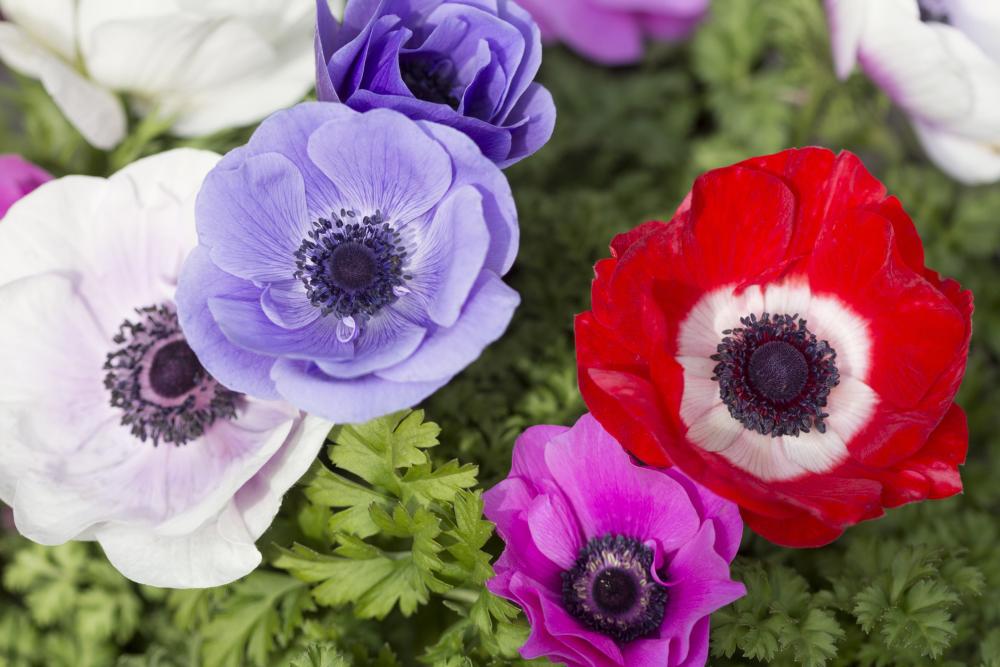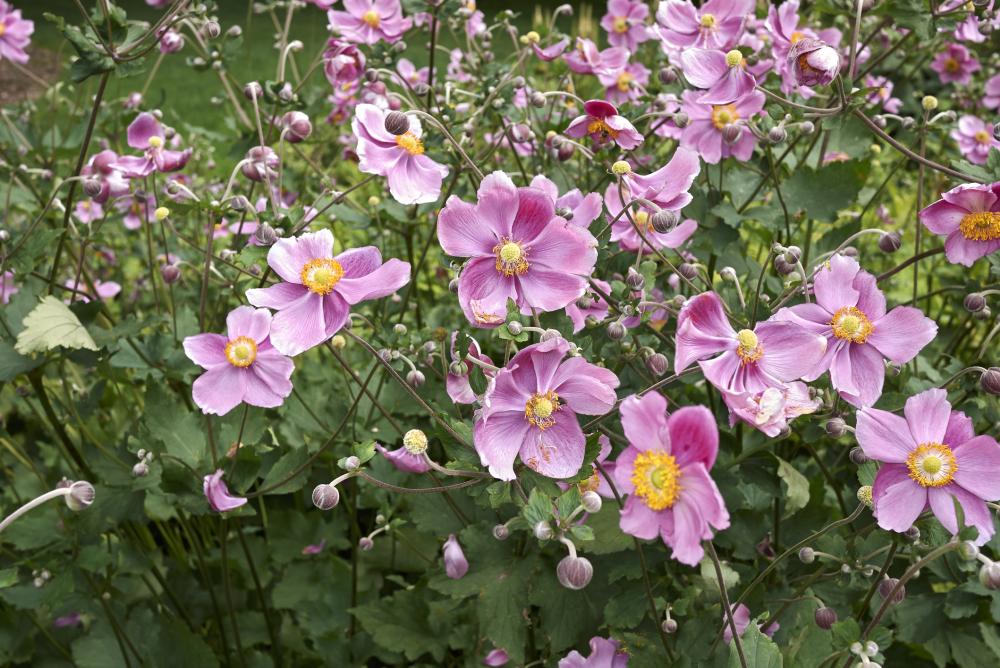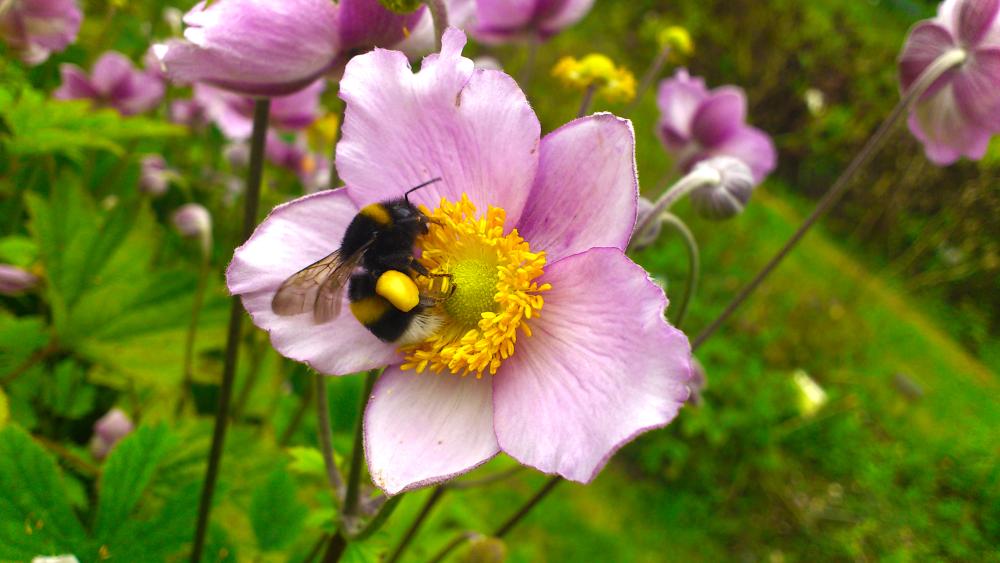Anemone Care - How To Grow And Harvest Anemones
The ubiquitous anemone is the novice gardener'due south best friend. The flower practically grows with piddling to no effort on your role and delights you with its bright and rich colors. Information technology'south the ideal plant for just almost whatsoever spot in your garden. When you run out of ideas and don't know what to grow in that spot betwixt the rose bushes and the veggie garden, you can fill the gap with the anemone or windflower, as it's sometimes called.

Near walls, fences, or lining up walkways, the versatile anemone is not finicky about its placement in the garden, nor does it ask for much in terms of care and maintenance. Read on to find out more about this literal salt of the earth of all flowering plants.
All About Anemone
The anemone is a member of the buttercup family and is distinguished with its open and polish flowers balanced precariously on height of slender stems. Whenever a slight breeze blows off, the stems tremble, sending the bloom swaying every which style. This is where it got the proper name windflower from.
The flower exists practically in every temperate and subtropical part of the globe. The but places information technology hasn't conquered are Commonwealth of australia and New Zealand due to their geographical seclusion. But no matter where it grows, the anemone will always accept the same distinct features that are easy to recognize.
Along the slender stems, leaves grow in abundance. They might be simple and round with a pointy tip, or they could exist divided and lobed. Different varieties accept different leafage structures. Merely information technology's the flower that is the main claim to fame for the anemone.
They bloom in the spring and summer and fill the place with different vivid colors. These range from red and white to royal, pinkish, aureate, and creamy. Each stem carries only i flower with 5 petals and a dark disc in the middle.
Afterward the flowers pollinate, they fade, and clusters of ovoid fruits develop at the center of the female flowers. The fruits are nothing more than sacs conveying the corms of the plant. Past the fall, the fruits crack open, and the corms drop to the basis where they're ready to sprout right away.
Anemone Varieties

Some anemone varieties are perennial, while others are annual. In general, in that location are two types of anemone, non-tuberous and tuberous. Under each type, you will find unlike species of the plant, each with its unique ornamental features. Hither are some of those varieties.
- Meadow Anemone: This non-tuberous anemone is native to North America. It grows to near 24 inches at most and produces large flowers in clusters of twos. The middle of the flower is white, unlike other anemones with dark centers. The blooming season starts in the early spring and continues until the early summer.
- Grecian Windflower: A tuberous anemone native to the East Mediterranean. The plant grows to about 12 inches at most and has beautiful flowers that come in shades of imperial, blood-red, white, and heaven blue. The leaves are no less ornamental and are covered with fuzz.
- Japanese Anemone: A not-tuberous hybrid first developed in Japan. The hybrid grows to about 2 feet and sometimes volition accomplish 4 feet in the correct conditions. It'south characterized by nighttime dark-green and fuzzy leaves and loving cup-shaped flowers. The blooms tin can be white, regal, rose, or pinkish.
- Snowdrop Anemone: A non-tuberous species native to Europe. The mature anemone grows to 18 inches high, and each stem carries clusters of ii flowers at about. The flowers, however are larger than other anemones and reach near three inches in diameter. They come in shades of purple, pink, and rose with yellowish or white centers.
- Scarlet Windflower: A tuberous anemone with ruby-red flowers and blackness centers. The mature plant grows to 12 inches high and merely comes in limited shades of copper and rust.. Like many other anemones, information technology blooms in the spring until the early summer when the oestrus forces the flowers to seed.
How to Grow Anemone
Since anemones abound practically anywhere, the corms are readily available either in stores or if y'all take a stroll in nature, where the plants grow in abundance. The corms develop in the summer and are fix to plant in the autumn. And so you can plant them either in the autumn or in the early spring before the bloom season. If the winter in your zone is mild, you tin can fifty-fifty found them in the late wintertime, where they will be ready to bloom in the springtime. Hither's how to start the charming anemones in like shooting fish in a barrel steps.
- Although you can outset anemones any time of the year when the temperature is moderate, the fall is the ideal season, and the blooms are more arable.
- The corms of anemones wait like withered acorns. But they're quite good for you and have a loftier success rate of germination.
- Soak the corms in room-temperature water for at least 4 hours before planting them. This softens the outer shell and fills up the withered skin with wet which speeds up formation.
- Fill up a tray with general-purpose potting mix to pre-sprout the corms. Plant the soaked corms in the soil one-half an inch deep and cover them with soil. H2o the tray until it gets moist.
- Go on the tray in a absurd room for 14 days. Don't let the soil dry out. Keep it moist until the corms sprout.
- When the roots on the corm grow to about a half-inch, pull them out of the tray and plant them in the garden.
- Till the top 10 inches of the soil in a sunny spot in your garden and mix in two inches of organic materials for every ane square foot of soil.
- Dig a 3-inch hole for every corm and constitute the sprouted corm with the roots facing downward.
- Infinite the corms 6 inches apart and h2o the soil thoroughly after planting to help information technology settle.
Anemone Intendance
Although starting anemones seems like a difficult job, it gets easier the more you do it. And one time it's growing in your garden, your job is almost done. The hardy plants don't demand much care and can survive on basic water and feeding. The ane affair you'd need to pay attention to is winterizing the floral plant, especially if the wintertime gets rather cold at night.
Soil
Most anemones thrive in rich soil. The soil has to exist well-drained as the anemone doesn't practise well in waterlogged soil. So if your garden soil is clayish, better it with sand until information technology absorbs the water quickly. To examination the soil texture, catch a fistful of the dry out soil and clench your hand on information technology. If it turns into a lump, the soil is heavy and needs more sand or perlite. Loose soil will sideslip between your fingers. Also, test the soil pH. The anemone prefers neutral to slightly acidic soil. Improve the soil with lime to bring the pH reading to something between five.six to vii.five.
Water
Too every bit liking to feed on loftier-quality nutrients, the anemone prefers the soil to be regularly moist. Dry soil sends the found into a tizzy, and stress tin can play havoc with the flowering patterns. In severe cases, the plant will not flower at all. So keep it well hydrated with i inch of h2o every week, including rainfall. If it rains, hold off the water until the top one inch of the soil dries out. If it doesn't pelting, water, it is regularly betwixt ii to 3 times a week depending on how hot the weather condition is and how fast the water drains. Once the last flower has dropped, cut the water by half and permit the soil in the fall and wintertime to go dry between irrigations.
Fertilizer
The anemone likes to take plenty of organic materials in the soil. Their deadening-release qualities continue the hungry plant fed for weeks on end. It also enjoys a quick-release chemical fertilizer, peculiarly with high concentrations of nitrogen and phosphorus. But timing is of the essence and so that you don't accidentally suppress the blossom buds and smother them with nitrogen. In the early on spring, apply a nitrogen-loftier fertilizer to bring the plant out of dormancy and trigger root and foliage growth. Then from the mid-spring, switch to a phosphorus-high fertilizer to encourage the flower buds. Apply the fertilizer once every two weeks during the growing flavor. Side clothes with aged manure and rabbit manure compost tea. In the fall and winter, the constitute stops growing, and so at that place's no need for fertilizing during those seasons.
Winterizing
Although the anemone is a absurd-season plant, when the temperature drops to frost level, the found will not survive through the winter. So you lot need to arbitrate and prepare the plant for the cold winter months. If you're growing anemones in containers, then winterizing means taking the pots within until the terminal frost is over. If they're growing in the garden, then prune them heavily, leaving a few inches of the principal stalk higher up the ground. Utilise row covers to protect the plants from the frost and frigid temperatures at nighttime. Cover the soil with a thick layer of mulch to forestall the roots from freezing over. After the last frost, remove the covers and mulch, then water the establish and feed it equally usual.
Pests and Diseases
The main pest that gives the anemone a hard time is the nematode. These are tiny worms that are difficult to detect with the naked eye. But just considering they're small doesn't mean they won't cause damage to the foliage. They feed on the inside of the leaf, causing it to wither and turn yellow. They block the vessels that carry nutrients and moisture to the leafage. This interferes with the constitute'south ability to photosynthesize sunlight. Eventually, the plant succumbs and dies.
The nematodes hibernate in the soil and become active in the spring and summer. So one way to eliminate them is to plough up the soil before planting and let it rest in the lord's day. You should besides remove infected leaves and stems to prevent the spread of the worms to other plants.
There are no notable diseases that afflict the anemone.
Harvesting Anemone

Anemones are known for their long vase life. And to get the most out of them, you lot need to wait for the flower to rise almost a quarter-inch above its leaf neckband before yous cut information technology. Immature anemones are not mature and wither rapidly in one case cut. The same applies to older anemones that yous leave on the institute for too long. So hit the sweet spot and cut the flowers at the right tiptop.
Always use sterilized shears or scissors to cutting the anemones. This prevents infecting the plants and the flowers themselves. Harvesting anemones regularly not simply triggers more flowers to emerge but also allows the stems to grow between flowers.
Don't harvest anemones during cold or rainy spells. This causes the petals to become blotchy, and these flaws won't heal after you cut the flowers. Choose a sunny solar day to cut the flowers early in the morning time.
Source: https://www.diys.com/anemone-care/
0 Response to "Anemone Care - How To Grow And Harvest Anemones"
Post a Comment